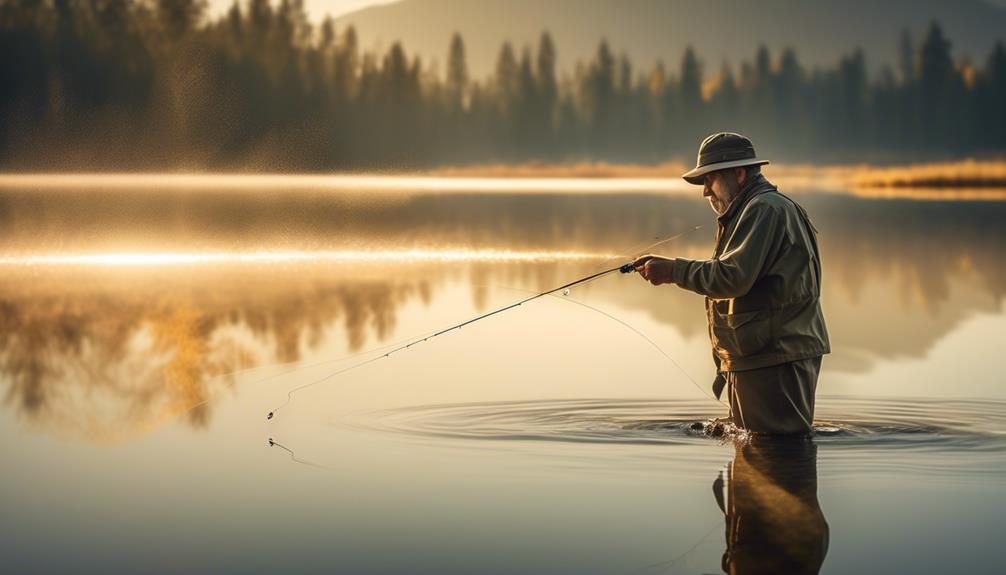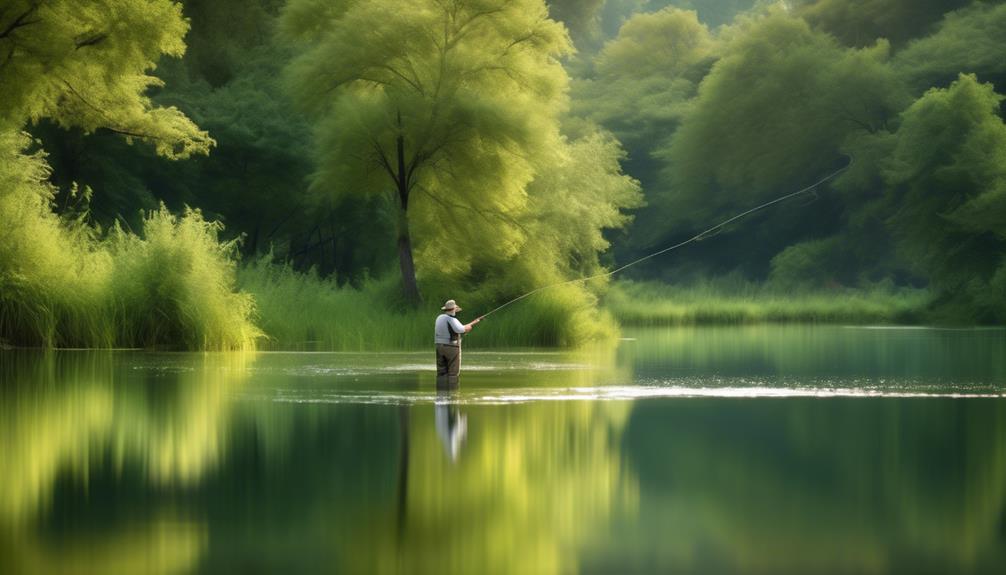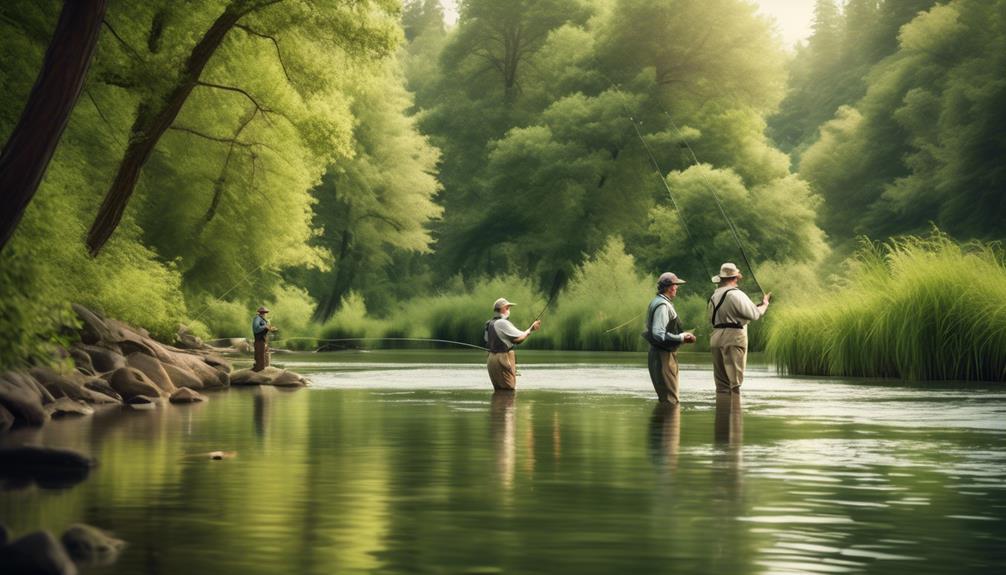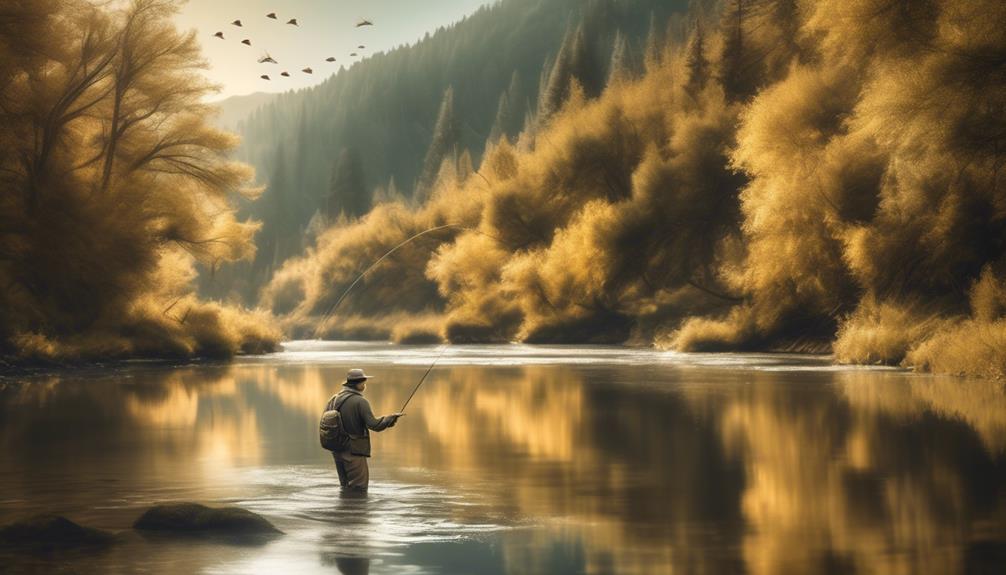You know the saying, 'Give a man a fish, and you feed him for a day; teach a man to fish, and you feed him for a lifetime.'
When it comes to bass fly fishing in lakes, mastering the right techniques can make all the difference in your success.
From selecting the perfect fly to understanding bass behavior and navigating different weather conditions, there are key strategies that can significantly improve your bass fly fishing game.
Whether you're a seasoned angler or just starting out, these techniques could be the game-changer you've been looking for.
Choosing the Right Fly
When selecting the right fly for bass fly fishing in lakes, consider the specific insect or prey that the bass are actively feeding on. Fly selection is crucial to success. Bass are opportunistic feeders and will go after insects, small fish, or even small mammals. It's essential to observe the water and identify the prevalent insects or baitfish to choose the right fly. Matching the hatch is a common fly fishing term, meaning selecting a fly that closely resembles the natural insects or baitfish in the water. This increases the chances of enticing a bass to strike.
When it comes to fly selection, it's vital to have a variety of flies in your tackle box. Different patterns and sizes can mimic various insects and baitfish. Some popular fly patterns for bass fly fishing include woolly buggers, clouser minnows, poppers, and streamers. Woolly buggers are versatile and imitate small baitfish or aquatic insects, while poppers create surface disturbance, attracting bass in shallow areas. Clouser minnows are effective for imitating baitfish, and streamers are great for mimicking larger prey.
Casting techniques play a significant role in bass fly fishing. It's essential to practice accurate casting to specific spots where bass are likely to be hiding, such as around structures like fallen trees, rocks, or submerged vegetation. Work on your accuracy and distance to ensure that the fly lands where the bass are likely to strike. Additionally, mastering the retrieve techniques is crucial for enticing the bass to strike the fly. Varying the speed and action of the retrieve can make the fly appear more natural, increasing its appeal to the bass.
Targeting Structure and Cover
To effectively target structure and cover for bass fly fishing in lakes, ensure that your casting accuracy and retrieve techniques are honed to entice strikes from bass hiding around these features. When targeting structure and cover, employing a stealth approach is crucial to avoid spooking the bass. Here are three key techniques to help you effectively target structure and cover for bass fly fishing in lakes:
- Casting Accuracy: To effectively target bass around structure and cover, you need to be able to accurately place your fly close to the target. Practice casting near obstacles such as fallen trees, docks, or submerged vegetation to simulate real fishing conditions. This will help you develop the precision needed to reach those hard-to-reach spots where bass often lurk.
- Stealth Approach: When fishing around structure and cover, approach the area quietly and cautiously. Bass are sensitive to disturbances, so avoid making unnecessary noise or sudden movements that could alarm the fish. By maintaining a low profile and using a stealthy approach, you can increase your chances of enticing strikes from bass hiding in these areas.
- Fishing Depth and Lure Selection: Understanding the depth at which bass are holding around structure and cover is essential. Use sinking lines or weighted flies to reach the desired depth. Additionally, selecting the right lure that mimics the natural forage in the area can significantly improve your success. Pay attention to the type of prey available and choose a fly that closely resembles it to entice strikes from bass.
Mastering the Retrieve
Master your retrieve technique by varying the speed and cadence of your fly to effectively entice strikes from bass in different lake environments. Improving accuracy in your retrieve is crucial for enticing bass to strike. When retrieving your fly, focus on making accurate casts to specific targets such as submerged structures, weed beds, or drop-offs. By casting accurately and placing your fly in the right spot, you increase the chances of triggering a strike from a bass hiding in the cover.
Managing line tension is another vital aspect of mastering the retrieve. Keeping the right amount of tension on the line allows you to feel the subtle takes and strikes from bass. It also enables you to set the hook quickly and effectively when a bass strikes. To manage line tension, stay attuned to the movements of your fly and maintain a gentle but consistent tension on the line. This will help you be ready to set the hook at the first sign of a strike, increasing your hookup rate.
As you work on mastering the retrieve, pay attention to the behavior of the bass in different lake environments. Vary your retrieve speed and cadence to match the activity level of the bass. Slow, methodical retrieves may work well for enticing sluggish bass in cold water, while faster, erratic retrieves can trigger strikes from aggressive bass in warmer conditions. By mastering the retrieve and incorporating these techniques, you can significantly improve your success in catching bass while fly fishing in lakes.
Understanding Bass Behavior
Understanding bass behavior is essential for successful fly fishing in lakes. By comprehending the intricacies of their feeding patterns, spawning behavior, seasonal movement, and habitat preferences, you can significantly improve your chances of a successful fishing trip. Here are a few key points to consider:
- Understanding Feeding Patterns: Bass are opportunistic feeders and tend to be most active during low light conditions such as dawn and dusk. They're also drawn to areas with abundant food sources such as weed beds, submerged structure, and drop-offs. By understanding their feeding habits, you can strategically position your fly to entice a strike.
- Spawning Behavior: During the spawning season, bass become territorial and protective of their nests. It's important to be mindful of these areas and avoid disturbing them, as this can negatively impact the bass population in the long run.
- Seasonal Movement and Habitat Preferences: Bass exhibit seasonal movements in response to changes in water temperature. In warmer months, they may seek cooler, deeper waters, while in colder months, they may move to shallower areas. Understanding their preferred habitats during different seasons can help you locate and target them more effectively.
Navigating Weather Conditions
When fly fishing for bass in lakes, adjusting your approach to suit the prevailing weather conditions can greatly impact your success on the water. Handling wind and rain is a crucial aspect of navigating weather conditions while bass fly fishing. When faced with windy conditions, it's essential to adjust your casting technique. Try casting at a lower angle to the water to minimize the impact of the wind on your line. Additionally, using heavier flies can help with casting accuracy in windy conditions.
In the event of rain, having appropriate waterproof gear is essential for staying comfortable and maintaining focus on your fishing. Consider investing in high-quality rain gear and a waterproof fly box to protect your flies from getting waterlogged.
Adapting to temperature fluctuations is also key when fly fishing for bass in lakes. Bass tend to be more active in warmer water, so adjusting your fishing style to account for temperature changes can be beneficial. In cooler temperatures, bass may be less active and prefer slower presentations. You might want to try using slower retrieves and targeting deeper water where bass may seek warmth.
On the other hand, in warmer temperatures, bass may be more active and willing to chase faster-moving flies. Experiment with different retrieval speeds to find what works best in varying temperature conditions. By adapting to temperature fluctuations, you can increase your chances of a successful bass fly fishing experience in lakes.
Selecting the Best Equipment
To ensure a successful bass fly fishing experience in lakes, selecting the best equipment is crucial for maximizing your chances of landing a catch. When it comes to bass fly fishing, the right rod selection and reel choice are essential for casting accuracy and control. Opt for a fast-action rod with a strong backbone to handle the fight of a large bass. Pair this with a quality reel that provides smooth drag and can accommodate the weight of the line.
Next, consider the line weight and leader material. A heavier line weight, such as 7-9 weight for bass fly fishing, allows for casting larger flies and handling the resistance of a fighting bass. Additionally, choosing the right leader material is crucial. For bass, a sturdy monofilament or fluorocarbon leader in the 10-16 pound test range is recommended to withstand the bass's aggressive strikes and sharp teeth.
Perfecting the Presentation

In fly fishing for bass in lakes, achieving a precise and enticing presentation is vital for luring in these elusive and often wary fish.
To perfect your presentation, start with line control. Proper line control allows you to effectively manage the movement of your fly, ensuring it appears natural to the bass.
Utilize smooth, controlled casts to place your fly accurately where the bass are likely to be. Casting accuracy is crucial, as it can make the difference between a successful presentation and a missed opportunity.
Additionally, consider depth adjustment and fly selection. Bass often inhabit different depths depending on factors such as temperature and time of day. Use sinking lines or weighted flies to reach the desired depth where the bass are feeding.
Moreover, selecting the right fly pattern is essential. Match the size and color of the fly to the prevalent forage in the lake to increase the chances of enticing a strike. Experiment with various retrieves to find the most effective presentation style for the day.
Exploring Topwater Tactics
Consider experimenting with different topwater fly patterns to entice bass in lakes. When it comes to topwater tactics for bass fly fishing, there are several effective techniques that can help you maximize your success on the water. Here are three key points to keep in mind:
- Surface Patterns: Choosing the right topwater fly pattern is crucial for enticing bass to strike. Surface patterns such as poppers, sliders, and foam bugs can mimic the movement of natural prey and create enticing disturbances on the water's surface. Experimenting with different patterns can help you determine which ones are most effective based on the behavior of the bass in a particular lake.
- Lure Selection: Pay attention to the water conditions and adjust your lure selection accordingly. Factors such as water clarity, temperature, and the presence of cover can influence the effectiveness of different topwater fly patterns. For example, in clear water, natural-looking patterns may yield better results, while in murky water, brightly colored or noisy patterns might be more effective at grabbing the attention of bass.
- Topwater Strikes: When fishing with topwater flies, be prepared for explosive strikes. Bass are known for their aggressive surface strikes, and it's important to stay alert and ready to set the hook when you see or feel a bass hitting your fly. Maintaining a steady retrieve and resisting the urge to set the hook too soon can increase your chances of hooking into a bass during a topwater strike.
Frequently Asked Questions
What Are the Best Times of Day to Fly Fish for Bass in Lakes?
For fly fishing bass in lakes, the best times to fish are early morning and late evening. Bass are most active during these times. Use topwater baits like poppers or streamers to entice them to strike.
How Can I Locate the Best Fishing Spots Within a Lake?
To locate the best fishing spots within a lake, start by finding structure like submerged logs or rocky areas. Understand currents by observing how wind and water flow. These factors can help you pinpoint where bass are likely to gather.
Are There Any Specific Types of Line or Leader Material That Work Best for Bass Fly Fishing in Lakes?
When bass fly fishing in lakes, use a weight-forward floating line for casting ease. Fluorocarbon leaders offer stealth but may sink your fly. Mono leaders float but are less invisible. Experiment to find what works best for you.
What Are Some Effective Ways to Avoid Spooking Bass While Fly Fishing in Lakes?
When fly fishing for bass in lakes, avoid spooking them by using stealth techniques. Approach slowly and quietly, and focus on casting distance to keep your fly line from landing too close. This will help you catch more bass.
Are There Any Specific Fly Patterns or Colors That Are Particularly Effective for Bass in Lakes?
When fly fishing for bass in lakes, use top fly patterns like woolly buggers and Clouser minnows. Effective color choices include black, olive, and white. These patterns and colors can attract bass in various lake conditions.
Conclusion
Now that you have learned the best techniques for bass fly fishing in lakes, it's time to hit the water and put your skills to the test.
Remember to:
- Choose the right fly
- Target structure and cover
- Master the retrieve
- Understand bass behavior
- Navigate weather conditions
- Select the best equipment
- Perfect the presentation
- Explore topwater tactics.
With practice and patience, you'll be reeling in bass like a pro in no time.
Happy fishing!



